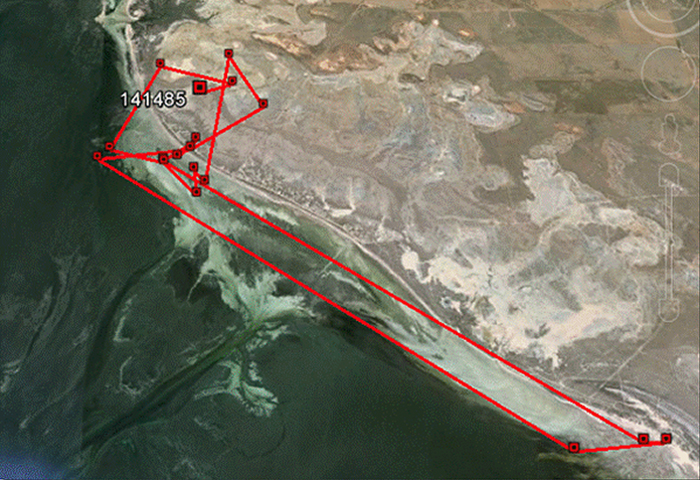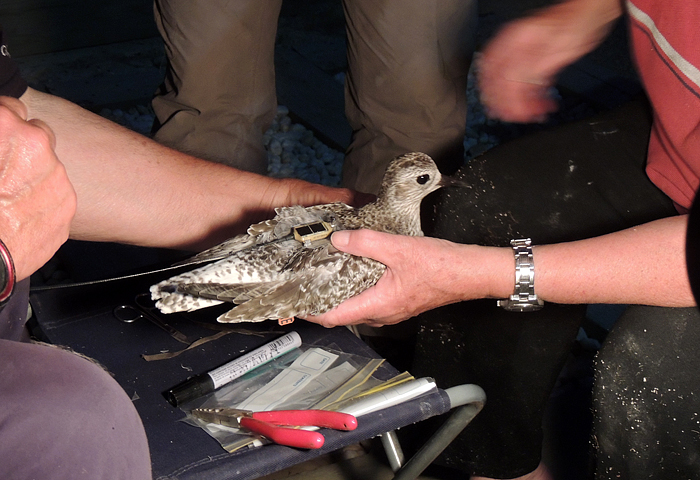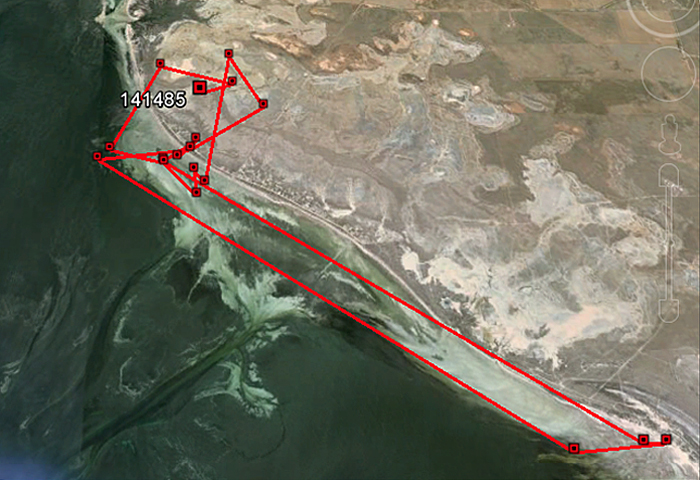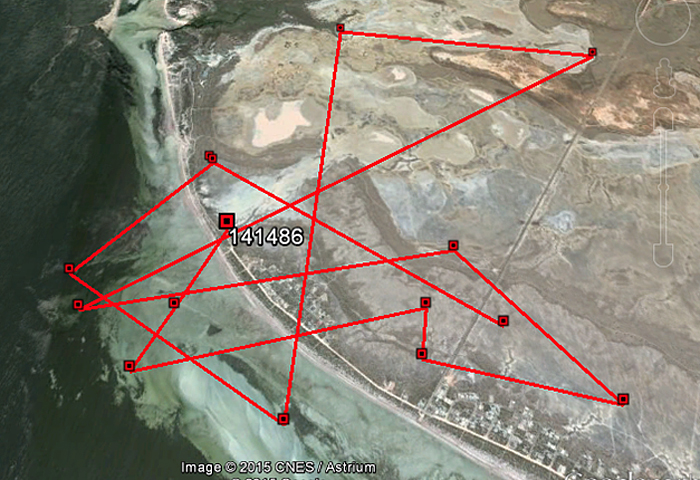Grey Plover 2015
May 25, 2015
Migration started – but…
We have been delighted with the data collected about Grey Plover movements in the Thompson Beach area, with a strong correlation between tide levels and where plover were feeding/roosting. Typically plover were utilising the mudflats at low tide, but rep airing inland, to the sabkhas behind the town at high tide. C-ME-fly was also recorded using the floating weed mats between Port Prime and Light Beach as well as the isolated beach opposite. Until now it has not been realised just how important a role the sabkhas play in providing habitat for migratory shorebird species.
Then, on 21st April, we were thrilled to see C-ME-fly leave on migration, making a direct flight from Thompson Beach, across the continent to north of Derby seemingly making for Indonesia. However, we were concerned that she had made a right-angled turn in her track. Perhaps a temporary change in course? But the area was buffeted by a very significant, large low-pressure system that had severe thunderstorms embedded in it. Such a system is unusual to occur in April and could have resulted in C-ME-fly being lost at sea. Unfortunately there have been no further transmissions.
Meanwhile, what of CAN-do? Both C-ME-fly and CAN-do had transmissions from Thompson Beach on 19th April. Whilst C-ME-fly departed on migration, there have been no transmissions from CAN-do away from Thompson Beach. Perhaps she also migrated in the same flock as C-ME-fly, with the satellite failing to pick up a transmission? Perhaps she shed her backpack? Perhaps, like Bar-tailed Godwit E3, which returned to her home base in New Zealand some months after its transmitter ceased working, CAN-do will be observed back at her ‘home base’ next summer?
That last transmission received from C-ME-fly was on the 21st April, north of Derby. The last transmission from CAN-do was on the 19th April, from Thompson Beach. Holly, from the team at Argos Satellites, has said that she has seen transmitters, particularly the solar powered ones, transmit after months of nothing ….But the chances are low that we will hear more from these transmitters now.
And yes, the use of the feminine pronoun was chosen deliberately. We collected feathers shed during catching/processing and sent them for DNA testing. All three were females. As are the majority of Grey Plover that come to Australia!
All this exciting information would not have been collected without the enthusiastic help and support from a whole range of people from a whole range of groups. Thank you all.
Now, what of the future? We still have seven satellite transmitters for deployment next season. Acting on advice from the suppliers, they have been turned off and stored. They are brought out once a month to turn them on, charge their batteries, and check with Argos as to whether they are still transmitting.
Unless we hear more from the silent transmitters of CAN-do and C-ME-fly, further news will wait until the other transmitters are deployed next summer.

CME-fly movements around Thompson’s Beach 
CME-fly crosses the continent before transmission stops.
April 17, 2015
Satellite transmitters are on
Two Grey Plovers are carrying satellite transmitters that were applied at Thompson Beach, north of Adelaide. As well as the transmitters the birds are also wearing an engraved orange flag with a unique code ‘CAN’ and ‘CME’, (plus a yellow flag below), that can be read by telescope if you see them. If you do see any of the birds, either now, before they leave on their migration, or later in the year after they return, please report the sighting through the AWSG report form.
The birds will be known as ‘CAN – do’ and ‘C-ME fly’.

The birds were caught by the VWSG on Monday 23rd March 2015. To find out what habitat areas they utilise within the gulf, they will be regularly tracked by satellite.
Both birds have spent all of their time in the Thompson Beach area, continuing to spend low tide feeding out on the mudflats, and high tide either on the shore or on the sabkhas (the samphire/marshy area) behind the town. We expect them to begin their journey north any time soon.
Early movements from the birds are shown below and they clearly illustrate that the Grey Plovers are using the broad expanse of saltmarsh adjoining the gulf waters. Grey Plover have been seen in the claypans before, but they have not been seen so far from the shoreline.
It is very early days in this project, and we are learning how to best interpret and present the data. Data points are Doppler fixes, and they do not have the pinpoint accuracy of GPS points. Fixes are given grades of accuracy. The accuracy needed to interpret movements of the plover around their non-breeding grounds is of a different magnitude to that needed for the long distance of migration to the breeding grounds. With this in mind, the tracks presented here use only the most accurate fix. So, fixes that are joined by time-based lines may have gaps of several days between them.
Tracks below are for the period 4th April to 17th April. As we get more skillful and receive more points, a clearer picture of the movements will unfold.
Bird ‘C-ME-fly’ (transmitter #141485)
With transmitters deployed on 23rd March, a trial download of data on 25th of March was very encouraging, with a strong correlation between tide levels and where plover were. C-ME-fly, when first recorded, at 2.40am on the 24th March was feeding on mudflats at low tide, but moving into the sabkhas two hours before high t ide, and remaining there until returning to the shore to feed on offshore weed beds on the ebbing tide.
Then, on 7th April, C-ME-fly moves to the isolated beach opposite the floating weed mats between Port Prime and Light Beach. The weed mats float on top of the water, and so are available at all times of the tide. C-ME-fly is on the reed mats three hours before high tide, on the adjacent beach at high tide, and back out on the mats an hour after high tide.

The balance of the time was spent on the northern side of Rushkin Road (the main road into Thompson Beach) moving between the tidal mudflats and the sabakhas behind the town.
Bird ‘CAN-do’ (transmitter #141486)
The trial download of CAN-do’s transmitter on 25th of March was also very encouraging. It showed a similar pattern to C-ME-fly, feeding on mudflats opposite Ruskin Road at low tide, the opposite Bakers Creek (Webb Beach) before going into the sabkha at high tide. Interestingly, Maureen Christie had witnessed a flock of Plover flying north, wheeling at Bakers Creed, before flying inland where she later found them loafing in a saline pool.
For some reason for the current period, this transmitter has had very few fixes at the highest grade. This track is made up of the two highest grades, meaning that the track is not as accurate as for C-ME-Fly. However, the pattern of using both the tidal mudflats and the sabkhas behind the town is evident.

Initial tracks for CAN-do 
Thompson Beach and Gulf St Vincent